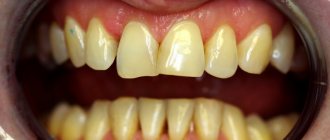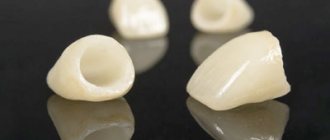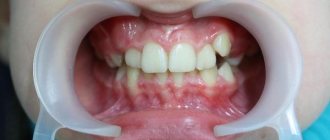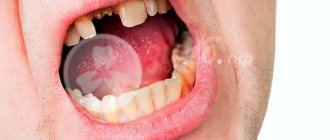Shaping the gum contour using temporary crowns
With one-stage dental implantation, when a tooth is removed and an implant is immediately installed in its place, a temporary crown (if it can be installed immediately) allows you to preserve the natural contour of the gum around the tooth, preventing the gum from filling the tooth socket.
If it was not possible to immediately install a temporary crown on a dental implant, and the gums have leveled out during the healing of the implant, then temporary crowns help form the correct gingival contour. Let's take a closer look at how this happens.
After the implants have healed, gum formers are screwed into them, which allow access to the implant to be created (sometimes gum formers are installed at the time of dental implantation).
Result after removal of the gum former:
The crown in the lower part has the shape of a cone, so with a special drill or laser the hole from above is expanded to give it a cone-shaped shape, like natural teeth. The expansion is performed under local anesthesia. The advantage of using a laser is that the vessels are immediately sealed and this operation is practically bloodless.
Temporary crowns for implants are made by an orthopedic dentist on the day of the patient’s visit using wax models prepared in advance in the laboratory. A temporary abutment (crown base) is screwed into the implant, and temporary crowns are fixed onto the abutment using temporary cement.
While wearing temporary crowns (about 2 weeks), the gums heal and finally take the desired shape, not only around the crown, but also filling the interdental space (gingival papillae are formed).
Temporary crowns are easily removed, since the fixing composition is not strong (this was done specifically so that the temporary crown can be removed without damaging the implant). If the crown falls off ahead of time, then it must be fixed in place as quickly as possible so as not to disturb the healing of the gums.
Having removed the temporary crowns after 2 weeks, the doctor sees a well-formed bed:
Impressions can now be taken to make permanent crowns that will look perfect from all angles.
While the permanent crowns are being manufactured, temporary crowns are re-installed on the implants.
After the permanent abutments and crowns are made, the temporary structures are removed and the permanent crowns are fixed onto the implants. Thanks to the preparation of the gums, permanent crowns look absolutely natural from all sides.
Without preliminary preparation of the gums, black triangles remain between the teeth, and food gets clogged between the teeth.
Thus, temporary crowns are necessary to create tight contact between the gum and the crown on the implant, which ensures not only aesthetics, but also the health of the gums and the ease of use of the crowns.
Stages of manufacturing and installation of temporary dentures
Making temporary structures is a fairly simple procedure that is carried out in several stages:
- Examination of the patient and determination of the possibility of installing prostheses.
- Sanitation of the oral cavity (treatment of dental diseases, removal of soft plaque and tartar).
- Preparation of abutment teeth.
- When using the direct restoration method, impressions of the dentition are made. The procedure then looks like this:
- Creating a jaw model with missing teeth.
- Examination of the mucous membranes of the oral cavity.
- Creation of a wax model of the prosthesis.
- Manufacturing of a prosthesis from the final material.
- Fixation of the structure using dental gel or glue.
- When using the indirect installation method, the production of temporary dentures occurs according to a template.
It takes 2-3 days to make temporary dentures. For production, aesthetically attractive materials are used that are sufficiently durable and match the color of tooth enamel. In most cases, composites or plastics are used. These materials are lightweight and absolutely safe - they do not harm healthy teeth.
How long can temporary crowns be worn?
Typically, temporary crowns are worn for no more than 2 months. Temporary crowns are made from plastic or composite polymers. These materials are quite porous and not very durable. Long-term wearing of temporary dental crowns is not recommended due to the strong accumulation of bacteria on the surface of the crown, which causes inflammation of the gums, as well as increased abrasion of the material.
Plastic temporary crowns can change color due to the use of coloring products - tea, coffee, red wine, etc.
Temporary crowns that will be worn for longer than 2 months are made from more durable materials.
Maintenance of the temporary structure
Artificial teeth require regular, careful care. If hygiene measures are neglected, plaque will accumulate under the dentures, causing bad breath and provoking the development of caries. In addition, inflammatory dental diseases can develop in the gum tissue. This will cause pain and swelling.
The main area on dentures that requires careful hygiene is located at the junction of the structure with natural teeth. You should also pay attention to the bottom of artificial crowns. Plaque accumulates especially heavily in these areas, so they should be cleaned with a toothbrush with medium-hard bristles, holding the brush at a 45-degree angle.
After each meal, it is necessary to rinse the mouth and brush your teeth using dental floss using gentle, smooth movements. For rinsing, you can use herbal decoctions or ready-made rinses.
It is recommended to periodically place the prosthesis in a special solution. The liquid can be prepared using denture tablets, which can be purchased at a pharmacy. Popular brands of such tablets are Protefix or Corega. After each use of the solution, it should be replaced.
In addition to recommendations for hygiene of temporary structures, you should adhere to the following tips:
- Avoid eating too hard foods (nuts, crackers, etc.).
- Try to chew food on the side of the jaw that is located opposite the denture.
Care instructions
The entire process of dental restoration using the implantation method, starting with implant placement and ending with crown installation, requires careful attention on the part of the patient. It is important not only to see a doctor, but also to take independent care of your oral health.
After fixing the temporary abutment, you must not:
- smoke;
- eat and drink during the first two hours;
- While the wound is healing, it is necessary to eat soft food, not very hot;
- clean the abutment carefully, avoid direct contact with the bristles of the toothbrush;
- rinse your mouth with antiseptic solutions;
- For minor bleeding and swelling, cold compresses can be applied.
Do not hesitate to ask your doctor any questions you may have. It is better to ask several times than to do it wrong and harm yourself.
How much can you use
The maximum service life of temporary abutments is 6 months, but 2-4 weeks are often sufficient for complete healing of the soft tissue, provided there are no complications. Only a doctor can decide when to remove a structure; you cannot do it yourself. During the first 2-3 days, the patient may experience bleeding, swelling or pain. After a few days they will disappear, if this does not happen, then you should consult a doctor. When the gingival contour has formed, the temporary system is replaced with a permanent one, after which the prosthesis is fixed.
What is a temporary abutment
This is a threaded metal rod equipped with a cylindrical head. Designs vary in shape, size and material. They are selected individually, depending on the area being prosthetized, the structural features of the teeth and the patient’s budget. Made from plastic or titanium.
Types of connecting elements:
- Standard - produced according to a template, universal.
- Individual - created using personal casts of the patient’s jaw, taking into account anatomical features.
A permanent abutment is a more complex design with a locking mechanism. The head protrudes significantly above the gum and determines the shape of the prosthesis. Installed at the final stage of implantation as a connecting element between the implant and the permanent crown.
Cost of temporary tooth restoration
Temporary dentures have almost the same price as permanent ones. The cost of structures depends on many factors:
- Type of prosthesis.
- Construction material.
- The number of teeth that need to be restored.
- The level of the clinic that provides the service.
- Qualification of specialists who are involved in the manufacture and installation of the prosthesis.
- The presence of diseases in the oral cavity that need to be cured before prosthetics, etc.
The exact cost of the procedure will be announced by a specialist after examining the patient’s oral cavity. The World of Dentistry clinic has reasonable prices that are affordable to most patients.
Features of application
Placement of temporary abutments is a standard practice used in traditional two-stage prosthetics. The design is a protective element that protects the pin integrated into the bone tissue from external pressure, and also prevents the entry of microbes and bacteria into the tissue that can cause a pathological reaction. In addition, the product allows you to form the correct position of the soft areas of the gum tissue, eliminating deformation during the period of implant healing.
Technically, the temporary abutment is made in the form of a cylinder, the material for the manufacture of which is a biologically compatible and safe titanium alloy. On one side there is a screw necessary to connect the abutment to the artificial rod. The size of the product depends on the technique used to fix the crown - the choice of parameters and dimensions takes into account the specifics of the future permanent prosthesis, forming in advance the correct contour of the surrounding tissue.










